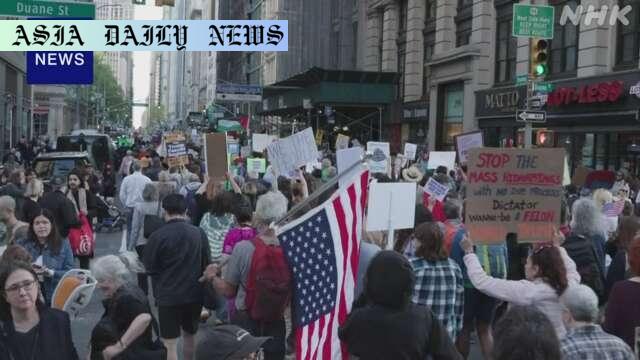Protests highlight concerns over Trump administration policies.
Protests against Trump’s administration held across the US.
Participants criticize executive orders and governance.
Focus on labor unions, immigrant rights, and other marginalized groups.
Concerns about democracy and constitutional integrity raised.

Introduction: The Rising Tide of Protests in America
On May Day, a global day of labor demonstrations, thousands of Americans took to the streets to voice their grievances against the administration of President Donald Trump. Demonstrations were held nationwide, with key events in major cities like New York, Los Angeles, and Chicago. The concerns raised by protesters were diverse, ranging from threats to democratic practices to the perceived undermining of labor rights.
The demonstrations were fueled by frustrations over Trump’s leadership, including his penchant for issuing executive orders — exceeding 140 since he took office. Many viewed these orders as bypassing democratic norms and accused the administration of eroding the nation’s foundational principles. In addition to political issues, participants highlighted socio-economic and human rights issues, such as cuts to the federal workforce, immigrant policies, and broader civil rights concerns.
Core Causes of the Dissatisfaction
Labor unions and advocacy groups for immigrant rights, sexual minorities, and other marginalized communities came together to express a collective opposition to the administration’s policies. The fusion of these diverse groups highlighted the multifaceted nature of dissatisfaction in contemporary America. Protesters pointed out that economic policies, such as budget cuts and job layoffs, impacted some of the country’s most vulnerable populations.
The criticism wasn’t just confined to Trump himself. High-profile figures like Elon Musk also came under scrutiny, particularly in his role leading the Department of Government Efficiency (DOGE). Protesters alleged that Musk’s approach to governance within the department was exacerbating systemic issues, resulting in widespread inefficiencies and neglect. These grievances highlight mounting discontent not only with the political style of the administration but also with key figures influencing public policy.
The Implications on Democracy and World Standing
One of the more striking arguments from protesters was the assertion that the United States is losing its status as a beacon of democracy. By comparing the current state of the nation to authoritarian regimes such as China, Russia, and North Korea, demonstrators warned of the significant and possibly long-lasting repercussions of current governance practices. The lack of adherence to constitutional protocols and recurring confrontations with the judiciary were cited as key elements of this concern.
Participants argued that these developments are not merely ideological battles but practical threats to the functioning of governance. By undermining judiciary independence and sidelining democratic processes, critics worry that the country could veer into dangerous territory, jeopardizing freedoms that Americans have long held dear.
A Broader Call for Change
The protests were not only about resistance; they also carried a strong demand for a better future. Labor unions, advocacy groups, and individuals hope to convince lawmakers and communities alike to re-engage with democratic principles, protect marginalized groups, and create a more inclusive national narrative. The emphasis on building solidarity between different communities highlighted how shared struggles can unite citizens in challenging times.
Ultimately, the May Day protests reflect a larger struggle for America’s direction in a highly polarized age. They serve as a stark reminder that the issues facing the country — be they constitutional integrity, labor rights, or social justice — are complex, interconnected, and deserve attention. While the path forward remains uncertain, the energy among protesters shows that the fight for accountability and transformation is far from over.



Commentary
Protests Represent a Call for Action, Not Just Resistance
The May Day marches across the United States serve as an important reminder of the enduring power of collective action. These demonstrations, though often polarizing, highlight a deep frustration felt by many Americans with the state of democracy, governance, and social equity in the country. What makes these protests noteworthy is not just their scale but also the breadth of issues they address — from labor rights to constitutional integrity.
Are We Paying Enough Attention to Constituent Voices?
Many of the concerns raised by protesters resonate deeply, especially their fears about the erosion of democratic norms. When a growing segment of the population feels disillusioned with the way their government operates, it’s a dramatic red flag for policymakers and citizens alike. The comparisons made to authoritarian regimes may seem extreme, but they reflect the anxiety that many feel about the direction the country is heading. Are we doing enough to safeguard democracy, or are we inadvertently undermining the very systems intended to protect it?
The Role of Advocacy in Shaping Change
What strikes me most about these demonstrations is the spirit of advocacy that runs through them. Protests are not just about opposing something; they are about demanding something better. Whether it’s immigrant rights, labor protections, or governmental accountability, the May Day marches showcase the potential of ordinary citizens to push for extraordinary changes. However, advocacy requires sustained action beyond one day of marching. It necessitates continued engagement, robust discussions, and efforts to bridge divisions to create lasting solutions.
In conclusion, the May Day demonstrations aren’t just events to observe but calls to action for everyone. They compel us to rethink our priorities, our policies, and ultimately the kind of society we want to live in. Only through dialogue and concerted effort can we hope to address the complex issues raised by these protests and move toward a more equitable future.